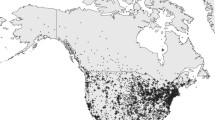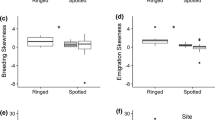Abstract
Spatial synchrony in population dynamics has been documented recently across a range of taxa, and a number of hypotheses about the mechanisms driving spatial synchrony and the consequences of this phenomenon for the persistence of populations have emerged. Spatial environmental covariance is one of the principal factors influencing this synchrony on a large scale. However, most studies focus on population abundances, and little evidence exists on the spatial synchrony of demographic parameters. We used a 15-year dataset from two populations of a vulnerable bird species, the Dalmatian Pelican (Pelecanus crispus), to identify local and global environmental factors that cause population synchrony. We show that survival rates were temporally synchronised between the studied populations and that a large part (>50 % for both populations) of this covariation was driven by local environmental conditions. Several components of the North Atlantic Oscillation index were correlated with local climatic conditions, but not all of these components can be used as informative proxies for future variation in survival. We also present evidence that an individual’s future survival can be strongly influenced by the conditions occurring during the early period of its life. Environmental factors such as water level and food availability had similar influences on breeding success and juvenile survival. Juvenile survival was lower during dry years and years of low food availability. This finding indicated that intra-specific competition may act as a limiting factor for species demography, especially in large populations. Estimating the strength of synchrony is important and should be considered in population and metapopulation analyses and in relationship to conservation measures.



Similar content being viewed by others
References
Albon SD, Clutton-Brock TH, Langvatn R, Brown RD (1992) Cohort variation in reproduction and survival: implications for population demography. In: Brown RD (ed) The biology of deer. Springer, New York, pp 15–21
Barbraud C, Weimerskirch H (2003) Climate and density shape population dynamics of a marine top predator. Proc R Soc B 270:2111–2116
Benton TG, Plaistow SJ, Coulson TN (2006) Complex population dynamics and complex causation: devils, details and demography. Proc R Soc B 273:1173–1181
Birt VL, Birt TP, Goulet D, Cairnse DK, Montevecchi WA (1987) Ashmoles halo: direct evidence of prey depletion by a seabird. Mar Ecol Prog Ser 40:205–208
Boyce MS, Haridas CV, Lee CT (2006) Demography in an increasingly variable world. Trends Ecol Evol 21:141–148
Burnham KP, Anderson DR (2002) Model selection and multimodel inference: a practical information-theoretic approach. Springer, New York
Catsadorakis G, Crivelli AJ (2001) Nesting habitat characteristics and breeding performance of Dalmatian Pelicans in lake Mikri Prespa, NW Greece. Waterbirds 24:386–393
Choi W, Ryoo M, Chung Y-J, Park Y-S (2011) Geographical variation in the population dynamics of Thecodiplosis japonensis: causes and effects on spatial synchrony. Popul Ecol 53:429–439
Choquet R, Reboulet AM, Pradel R, Gimenez O, Lebreton JD (2004) M-SURGE: new software specifically designed for multistate capture–recapture models. Anim Biodivers Conserv 27:207–215
Crivelli AJ (1987) A wetland of international importance. World Birdwatch 9:8
Crivelli AJ, Leshem Y, Mitchev T, Jerrentrup H (1991a) Where do Palearctic Great White Pelicans (Pelecanus onocrotalus) presently overwinter? Rev Ecol Terre Vie 46:145–171
Crivelli AJ, Mitchev T, Catsadorakis G, Pomakov V (1991b) Preliminary results on the wintering of the Dalmatian Pelican Pelecanus crispus in Turkey. Zool Middle East 5:11–20
Crivelli AJ, Hatzilacou D, Catsadorakis G (1998) The breeding biology of the Dalmatian pelican Pelecanus crispus. Ibis 140:472–481
Crivelli AJ, Marsili L, Focardi S, Renzon A (1999) Organochlorine compounds in Pelicans (Pelecanus crispus and Pelecanus onocrotalus) nesting at lake Mikri Prespa, north western Greece. Bull Environ Contam Toxicol 62:383–389
Crivelli AJ, Catsadorakis G, Hatzilacou D, Hulea D, Malakou M, Marinov M, Michev T, Nazirides T, Peja N, Sarigul G, Siki M (2000) Status and population development of Great White Pelican Pelecanus onocrotalus and Dalmatian Pelican P crispus breeding in the Palearctic. In: Yésou P, Sultana J (eds) Monitoring and conservation of birds, mammals and sea turtles of the mediterranean and black seas. Ministry of Environment, Malta, pp 38–46
del Hoyo J, Elliot A, Sargatal J (eds) (1992) Handbook of the birds of the world. Ostrich to ducks. ICBP, Lynx Edicions, Barcelona
Doxa A, Theodorou K, Hatzilacou D, Crivelli A, Robert A (2010) Joint effects of inverse density-dependence and extreme environmental variation on the viability of a social bird species. Ecoscience 17:203–215
Engen S, Lande R, Saether BE (2002a) Migration and spatiotemporal variation in population dynamics in a heterogeneous environment. Ecology 83:570–579
Engen S, Lande R, Sæther B-E (2002b) The spatial scale of population fluctuations and quasi-extinction risk. Am Nat 160:439–451
Frederiksen M, Daunt F, Harris MP, Wanless S (2008) The demographic impact of extreme events: stochastic weather drives survival and population dynamics in a long-lived seabird. J Anim Ecol 77:1020–1029
Grafen A (1988) On the uses of data on lifetime reproductive success. In: Cluton-Brock T (ed) Reproductive success. University of Chicago Press, Chicago, pp 454–485
Hanski I (1999) Metapopulation ecology. Oxford University Press, New York
Harrison S, Quinn JF (1989) Correlated environments and the persistence of metapopulations. Oikos 56:293–298
Hatzilacou D (1993) The distribution of the globally endangered Dalmatian Pelican Pelecanus crispus in Greece: threats pertaining to its habitats and recommendations for protection. UK Royal Society for the Protection of Birds, Sandy
Hatzilacou D (1999) Bird conservation in the Amvrakikos Gulf. Hellenic Ornithological Society and Vogelbescherming, Athens
Hegel TM, Verbyla D, Huettmann F, Barboza PS (2011) Spatial synchrony of recruitment in mountain-dwelling woodland caribou. Popul Ecol 54:19–30
Heino M, Kaitala V, Ranta E, Lindstrom J (1997) Synchronous dynamics and rates of extinction in spatially structured populations. Proc R Soc B Biol Sci 264:481–486
IUCN (2001) IUCN red list categories and criteria: version 3.1. IUCN species survival commission. IUCN, Gland
Lande R, Engen S, Saether BE (1999) Spatial scale of population synchrony: environmental correlation versus dispersal and density regulation. Am Nat 154:271–281
Lebreton JD, Burnham KP, Clobert J, Anderson DR (1992) Modeling survival and testing biological hypotheses using marked animals—a unified approach with case-studies. Ecol Monogr 62:67–118
Legendre P (1993) Spatial autocorrelation—trouble or new paradigm. Ecology 74:1659–1673
Lewis S, Sherratt TN, Hamer KC, Wanless S (2001) Evidence of intra-specific competition for food in a pelagic seabird. Nature 412:816–819
Lindstrom J (1999) Early development and fitness in birds and mammals. Trends Ecol Evol 14:343–348
Lindstrom J, Kokko H (2002) Cohort effects and population dynamics. Ecol Lett 5:338–344
McCarthy MA, Thompson CJ, Possingham HP (2005) Theory for designing nature reserves for single species. Am Nat 165:250–257
McCleery RH, Perrins CM (1988) Lifetime reproductive success in the Great Tit, Parus major. In: Clutton Brock TH (ed) Reproductive success: studies of individual variation in contrasting breeding systems. University of Chicago Press, Chicago, pp 136–153
Peja N, Sarigul G, Siki M, Crivelli AJ (1996) The Dalmatian Pelican Pelecanus crispus nesting in mediterranean lagoons in Albania and Turkey. Colon Waterbirds 19:184–189
Post E, Forchhammer MC (2004) Spatial synchrony of local populations has increased in association with the recent northern hemisphere temperature trend. Proc Natl Acad Sci USA 101:9286–9290
Post E, Stenseth NC, Langvatn R, Fromentin JM (1997) Global climate change and phenotypic variation among red deer cohorts. Proc R Soc B 264:1317–1324
Ranta E, Kaitala V, Lundberg P (1998) Population variability in space and time: the dynamics of synchronous population fluctuations. Oikos 83:376–382
Robert A (2009) The effects of spatially correlated perturbations and habitat configuration on metapopulation persistence. Oikos 118:1590–1600
Rose KE, Clutton-Brock TH, Guinness FE (1998) Cohort variation in male survival and lifetime breeding success in red deer. J Anim Ecol 67:979–986
Saether BE, Bakke O (2000) Avian life history variation and contribution of demographic traits to the population growth rate. Ecology 81:642–653
Saether BE, Lande R, Engen S, Weimerskirch H, Lillegard M, Altwegg R, Becker PH, Bregnballe T, Brommer JE, McCleery RH, Merila J, Nyholm E, Rendell W, Robertson RR, Tryjanowski P, Visser ME (2005) Generation time and temporal scaling of bird population dynamics. Nature 436:99–102
Shafer CL (2001) Inter-reserve distance. Biol Conserv 100:215–227
Shine R, Madsen TRL, Elphick MJ, Harlow PS (1997) The influence of nest temperatures and maternal brooding on hatchling phenotypes in water pythons. Ecology 78:1713–1721
Skalski JR, Hoffman A, Smith SG (1993) Testing the significance of individual- and cohort-level covariates in animal survival studies. In: Lebreton J-D, North PM (eds) Marked individuals in the study of bird population. Birkhauser Verlag, Basel, pp 9–28
Sorci G, Clobert J, Belichon S (1996) Phenotypic plasticity of growth and survival in the common lizard Lacerta vivipara. J Anim Ecol 65:781–790
Timmermann A, Oberhuber J, Bacher A, Esch M, Latif M, Roeckner E (1999) Increased El Nino frequency in a climate model forced by future greenhouse warming. Nature 398:694–697
Vuilleumier S, Wilcox C, Cairns BJ, Possingham HP (2007) How patch configuration affects the impact of disturbances on metapopulation persistence. Theor Popul Biol 72:77–85
White GC, Burnham KP (1999) Program MARK: survival estimation from populations of marked animals. Bird Study 46:120–139
Williams JC, ReVelle CS, Levin SA (2005) Spatial attributes and reserve design models: a review. Environ Mod Assess 10:163–181
Acknowledgments
We would like to warmly thank all the people who helped in the field and the Society for Protection of Prespa for all the data provided. We also thank Morten Frederiksen, two anonymous reviewers and the handling editor of the journal for comments on a previous version of this work. This study is part of the International Pelican research and management program of the southeastern Europe (Dr A.J. Crivelli, program leader) and funded by the Foundation Sansouire (France).
Author information
Authors and Affiliations
Corresponding author
Rights and permissions
About this article
Cite this article
Doxa, A., Theodorou, K., Crivelli, A.J. et al. Spatially correlated environmental factors drive synchronisation in populations of the Dalmatian Pelican. Popul Ecol 54, 499–507 (2012). https://doi.org/10.1007/s10144-012-0330-9
Received:
Accepted:
Published:
Issue Date:
DOI: https://doi.org/10.1007/s10144-012-0330-9




